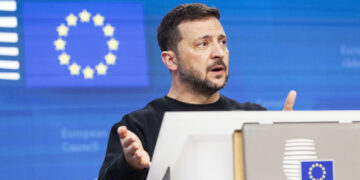The tariffs implemented by the Trump administration on 2 April are on a scale last seen in the 1930s, writes Robert Basedow. Effective diplomacy, strategic retaliation, cooperation with third countries and domestic reform will be needed to mitigate the damage for the EU and UK.
On 2 April, the Trump administration announced the introduction of very high US tariffs on imports. The US will levy a 10% tariff on all imports – including from the UK – and even higher tariffs on imports from a number of key trading partners such as the EU (20%), Japan (24%), South Korea (25%), China (34%) and Vietnam (46%).
These tariff levels are truly significant in historic perspective and were last seen in the 1930s, when the United States and other western economies engaged in heavy-handed protectionism and economic beggar-thy-neighbour policies. To contextualise, advanced economies such as the US and the EU have had average weighted tariff levels around 3-4% in the last decades.
The new US tariffs thus amount in some cases to a tenfold (or more) increase of the taxes that the US government will collect on goods entering the US economy. These taxes will swallow the profit margins of most exporters to the US and still leave their goods considerably more expensive than in the past. This will undoubtedly fuel inflation in the US, depress US consumption and demand for imports, and cost millions of jobs in Europe and elsewhere.
In other words, these tariffs are no “minor” trade irritant by any measure. They are designed to fundamentally reshuffle the economic geography of the world economy and global trade. Needless to say, they are very much incompatible with the rules and the spirit of the World Trade Organization, which indeed has taken another fatal blow.
Economic protectionism
According to the Trump administration, the tariffs are reciprocal and responses to sustained US trade deficits with these countries regarding goods. Europeans, for instance, sell more cars, wine and clothes to Americans than Americans sell to Europeans.
Apart from Ricardo’s comparative advantage, this perspective ignores that the US has equally high and sustained trade surpluses in services with the world. Europeans buy many more US services such as software, music and film streaming, and financial services than Americans buy from European firms. In reality, the EU, the UK and the US have indeed a fairly balanced trade relationship.
Judging on the basis of Trump policy statements and the republican electoral programme, the tariffs are largely here to stay. Unlike during the first Trump presidency, when US tariff increases were used as a tool to force other countries to the negotiating table on economic and non-economic issues, this round of tariff increases is predominantly about economic protectionism. Trump wants to reduce import competition for US manufacturers and workers to reinvigorate the Rust Belt and US industry, though with very questionable chances of success.
It may well be that Trump strikes narrow deals in the coming weeks with some countries on certain sectors or other pressing policy issues (such as drugs, migration, defence and organised crime) or partially changes his mind in the face of inflation and financial market reactions. Yet, such deals and Trump’s notorious volatility are unlikely to change the big picture. They won’t reduce tariff levels to anything considered normal since the 1980s and instil markets with a sense of predictability.
Diplomacy and retaliation
How then can the EU and the UK deal with this new global economic situation and indeed crisis? Overall, the EU and the UK must tackle three broad issue areas going ahead.
First, they need to hone their strategy to engage with the US and Trump. At least for the EU, this strategy most likely consists of diplomacy and flattering, the offering of concessions (such as lowering EU car and agricultural tariffs; pledging EU defence money to US contractors) and the use of strategic retaliation against products coming from US regions that have close links to key US decision-makers.
During the first Trump presidency, the EU retaliated against a round of US tariff increases by raising tariffs on US bourbon because the leader of the Republican majority in the US Senate, Mitch McConnell, is from Kentucky. The hope was that McConnell would face criticism from his electoral and business constituency and convince Trump to soften his trade policy stance. This time, it seems likely that the EU may also target big US tech companies and intensify efforts to introduce a digital tax.
The UK, in turn, is unlikely to pursue retaliation. Its small market size is unlikely to have any impact on the US and overall Whitehall has managed to maintain fairly amicable ties to Washington. The key priority for the UK will thus remain to strike a preferential trade agreement with the US to reduce the new 10% levy, which, in turn, may lead to increased EU investment in the UK.
After the experience with the Transatlantic Trade and Investment Partnership (TTIP), this route of negotiating a broad preferential trade agreement is manifestly unfeasible for the EU and undesirable for Trump, who ultimately has promised protection to US workers and firms from key competitors, notably in the EU. Yet, narrow sectorial deals between Brussels and Washington, for instance on cars and agriculture, may be realistic and politically doable.
Leveraging relations with third countries
The second question then is how the EU and UK can leverage their relations with third countries to mitigate the fall-out of US policies. In a nutshell, the US is taking demand out of world markets that will harm exporters around the world. To partially mitigate this demand shock, the EU and the UK must seek to deepen and stabilise their economic relations with fast growing world regions through preferential trade agreements.
For the EU, the obvious low-hanging-fruits are the preferential trade agreement with Mercosur, but also with India and Indonesia. All have been under negotiation for years making their conclusion within a limited timeframe feasible. A few years ago, the EU also considered an intercontinental preferential trade agreement with the African Continental Free Trade Area (AfCFTA), which may be an interesting route to pursue over the next years to diversify European export markets and supply chains.
The UK should follow in the EU’s footsteps as far as possible. Statistically speaking, the EU and the UK are, furthermore, becoming more important partners for China – and vice versa – as their economic ties with the US weaken. This shift may open the door to some frank discussions with Beijing about European concerns regarding China’s economic and trade policies and to update ailing WTO rules on subsidies. Yet, such discussions will surely be difficult and a long-term undertaking.
Bold reforms
Lastly, and most importantly, the EU and the UK must undertake bold domestic economic reforms to strengthen their economies’ resilience. The Draghi Report provides a comprehensive and recent to-do-list for national and European policymakers to pursue.
Apart from ensuring alignment between EU industrial policy initiatives and EU trade policies (such as diversification of supply chains through new preferential trade agreements), the EU may also want to decisively push ahead with the Capital Markets Union to ensure that European firms and start-ups have sufficient domestic access to funding to scale-up and innovate without having to relocate to the US. Indeed, the only way for the EU and UK to truly mitigate the external shock of US protectionism is to strengthen their domestic markets and demand.
Note: This article gives the views of the author, not the position of EUROPP – European Politics and Policy or the London School of Economics. Featured image credit: United States government work


































Discussion about this post